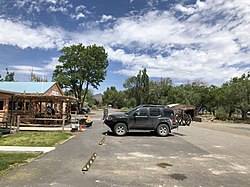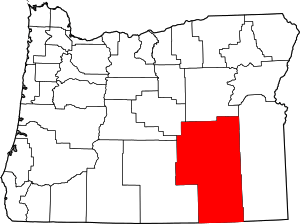Fields, Oregon
Fields is an unincorporated community in Harney County, Oregon, United States,[1] located 112 miles (180 km) south of Burns. It is the center of commerce for local ranches and the largest community between Denio, Nevada, 22 miles (35 km) to the south, and Frenchglen, Oregon, 52.4 miles (84.3 km) to the north.
Fields, Oregon | |
|---|---|
 Fields Station, June 2018 | |
 Fields  Fields | |
| Coordinates: 42.2643371°N 118.6751809°W[1] | |
| Country | United States |
| State | Oregon |
| County | Harney |
| Elevation | 4,236 ft (1,291 m) |
| Population (2010) | |
| • Total | 120 |
| Within zip code 97710[2] | |
| Time zone | Pacific |
| GNIS feature ID | 1120703 |
History
In 1881, Charles Fields established a homestead where the community of Fields is located today. Fields built a stagecoach roadhouse to serve the stage route between Winnemucca, Nevada, and Burns. A one-room school was established at the site around 1900 with one teacher. Fields sold his business to John Smyth in 1911. The Fields post office was opened two years later. The stone roadhouse was eventually remodeled into a store and restaurant, and is still in use. The original stone horse barn has partly collapsed, but remains in use. Today, the community of Fields consists of a bar, store, cafe, gas station, school, campground, and a few houses. As of 2003, the school has two rooms and two teachers serving kindergarten through eighth grade.[3][4][5]
Ranching began in the area in 1869 when Whitehorse Ranch was established. The Rose Valley Borax Company processed about 400 short tons (360,000 kg) of crystallized borax annually from 1892 to 1902. Chinese workers collected alkali formed from evaporating spring water containing 80 parts per million (ppm) borate.[4]
Climate
Averaging under 7 inches (180 mm) of precipitation per year, Fields is among the driest places in Oregon.[6][7] The nearby Alvord Desert may be the driest.[8] Fields, like the Alvord, experiences a continental or "cold" desert climate (Köppen climate classification BWk).
| Climate data for Fields, Oregon | |||||||||||||
|---|---|---|---|---|---|---|---|---|---|---|---|---|---|
| Month | Jan | Feb | Mar | Apr | May | Jun | Jul | Aug | Sep | Oct | Nov | Dec | Year |
| Record high °F (°C) | 61 (16) |
70 (21) |
78 (26) |
89 (32) |
97 (36) |
101 (38) |
106 (41) |
101 (38) |
96 (36) |
92 (33) |
76 (24) |
62 (17) |
106 (41) |
| Average high °F (°C) | 42.0 (5.6) |
45.8 (7.7) |
53.5 (11.9) |
58.8 (14.9) |
69.5 (20.8) |
79.3 (26.3) |
90.3 (32.4) |
88.1 (31.2) |
78.5 (25.8) |
64.7 (18.2) |
49.8 (9.9) |
40.9 (4.9) |
63.4 (17.5) |
| Daily mean °F (°C) | 32.4 (0.2) |
35.3 (1.8) |
41.9 (5.5) |
46.4 (8.0) |
55.9 (13.3) |
64.3 (17.9) |
74.7 (23.7) |
72.1 (22.3) |
62.8 (17.1) |
50.5 (10.3) |
38.7 (3.7) |
31.5 (−0.3) |
50.5 (10.3) |
| Average low °F (°C) | 22.7 (−5.2) |
24.8 (−4.0) |
30.3 (−0.9) |
33.9 (1.1) |
42.3 (5.7) |
49.3 (9.6) |
59.1 (15.1) |
56.1 (13.4) |
47.1 (8.4) |
36.2 (2.3) |
27.6 (−2.4) |
22.1 (−5.5) |
37.6 (3.1) |
| Record low °F (°C) | −20 (−29) |
−2 (−19) |
1 (−17) |
14 (−10) |
18 (−8) |
28 (−2) |
40 (4) |
35 (2) |
28 (−2) |
10 (−12) |
1 (−17) |
−7 (−22) |
−20 (−29) |
| Average precipitation inches (mm) | 0.80 (20) |
0.57 (14) |
0.62 (16) |
0.69 (18) |
0.86 (22) |
0.48 (12) |
0.19 (4.8) |
0.17 (4.3) |
0.31 (7.9) |
0.53 (13) |
0.59 (15) |
0.73 (19) |
6.54 (166) |
| Source: Western Regional Climate Center (period of record for averages is 5/1/1973 to 3/31/2013)[9] | |||||||||||||
Demographics
As of the 2010 census, the area of zip code 97710 had a population of 120, with 69 males and 51 females. Out of the 120 people, 119 identified as white. 19 members of the population (15.8%) were between 50 and 54 years old, the largest percentile. The average age was 44.5, and the average household size was 2.35 people.[2]
Recreation
Sightseers, hunters, and fishers often stop at Fields. Local wildlife include pronghorn, mule deer, elk, bighorn sheep, pheasants, doves, geese, and ducks. Rainbow trout are found in nearby streams. There are also publicly accessible hot springs in the area, including Alvord Hot Springs, Bog Hot Springs, and White Horse Hot Springs. Many photographers are interested in Steens Mountain, which is located about 60 miles (97 km) to the north.[5]
References
- "Fields". Geographic Names Information System. United States Geological Survey. November 28, 1980. Retrieved September 23, 2014.
- "2010 Demographic Profile Data: ZCTA5 97710". American FactFinder. U.S. Census Bureau. Archived from the original on February 12, 2020. Retrieved September 23, 2014.
- McArthur, Lewis A.; McArthur, Lewis L. (2003) [1928]. Oregon Geographic Names (7th ed.). Portland, Oregon: Oregon Historical Society Press. p. 351. ISBN 978-0875952772.
- "The Area". Alvord Inn. Archived from the original on July 26, 2013.
- "Fields, Oregon" Archived 2014-05-19 at the Wayback Machine, www.southernoregon.com. Retrieved April 21, 2014.
- "Oregon's Unique Climate". Oregon Photos. Retrieved September 22, 2014.
- "Oregon Annual Rainfall and Climate Data". Coolweather.net. Retrieved September 22, 2014.
- Lorain, Douglas (2011). 100 Classic Hikes in Oregon (Second ed.). Seattle, Washington: The Mountaineers Books. p. 239. ISBN 978-1-59485-492-7.
- "Fields, Oregon". Western Regional Climate Center. Desert Research Institute. Retrieved September 28, 2013.
